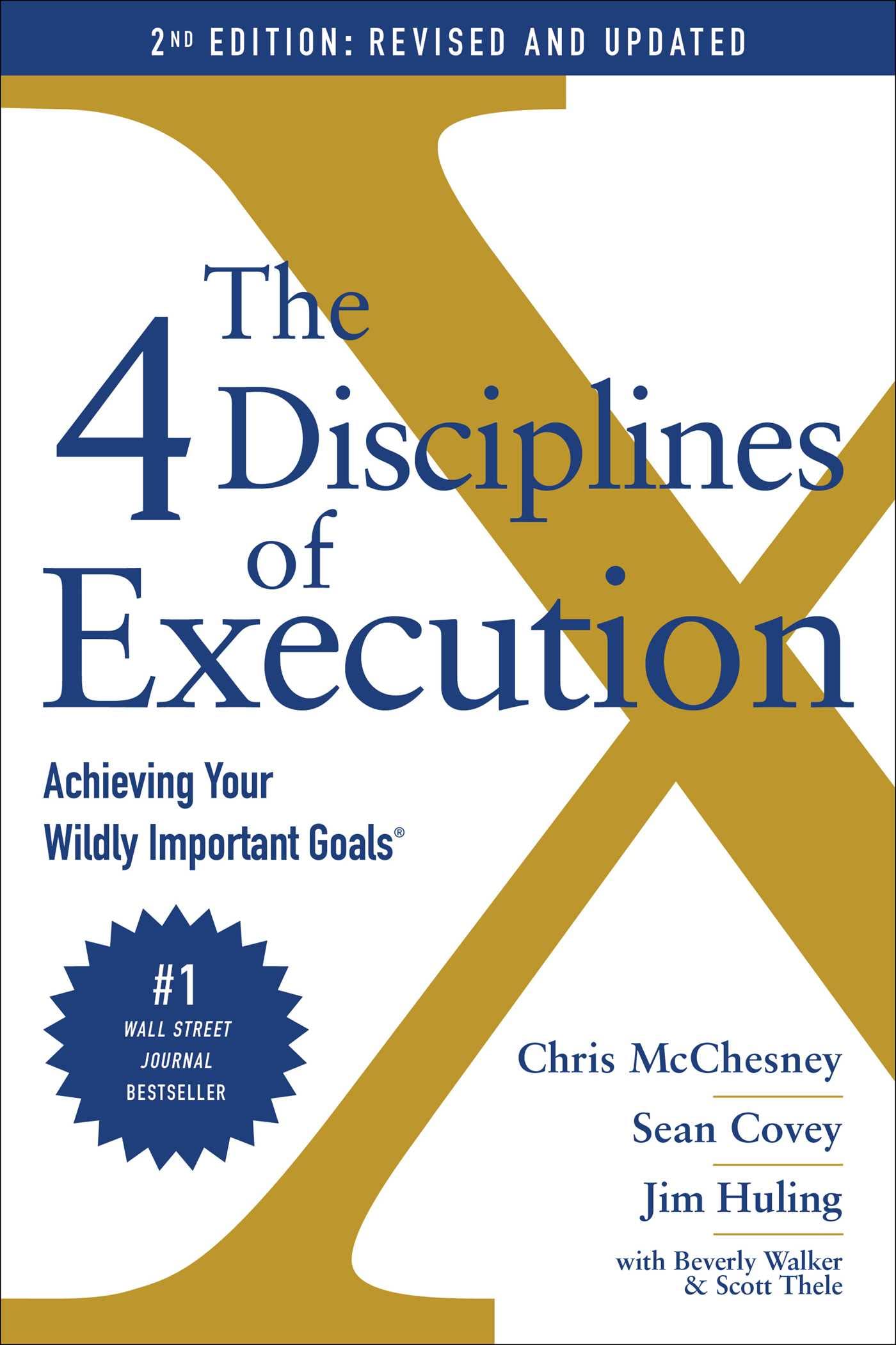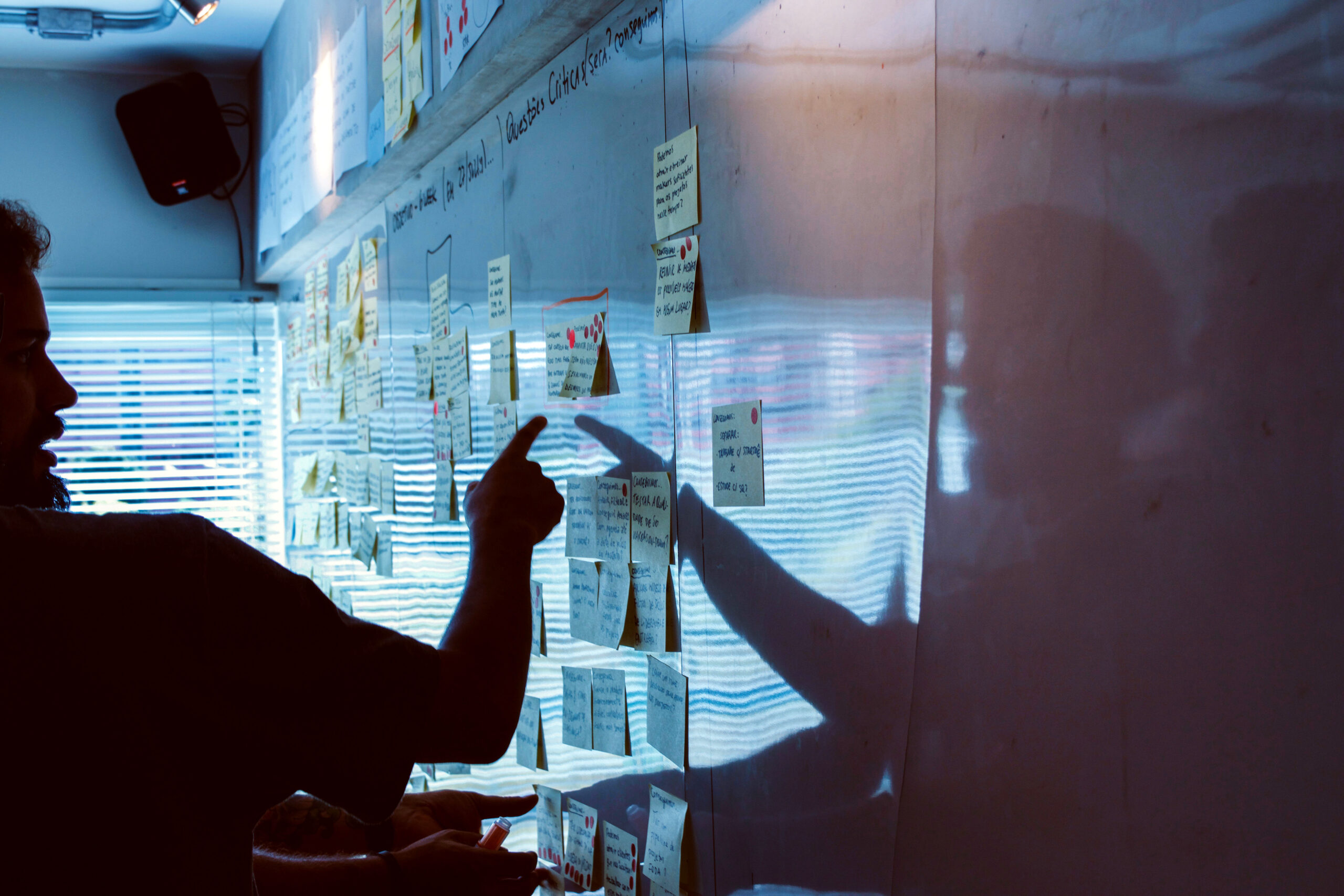We have found nothing that drives the morale and engagement of a team more than winning.
- Chris McChesney, Sean Covey, and Jim Huling Tweet
PART 1 – LEARNING THE 4 DISCIPLINES OF EXECUTION (4DX)
The initial section of the book, “The 4 Disciplines of Execution,” introduces the concepts and explains how discipline can help leaders overcome the challenges of executing strategies and meeting goals.
Chapter 1
The Real Problem With Execution
The 4 Disciplines of Execution offer a proven solution for leaders facing the challenge of implementing a strategy that requires behavior change. To drive results, focus on the Breakthrough Strategy rather than the whirlwind of daily tasks.
- The 4 Disciplines of Execution framework consists of:
- Wildly Important Goals: Identify and prioritize crucial objectives that align with the organization’s mission.
- Lead Measures: Pay attention to specific actions that have the greatest impact on achieving goals.
- Compelling Scoreboard: Create a visible and motivating scoreboard to track progress.
- Cadence of Accountability: Establish a regular rhythm of planning, reporting, and reviewing to hold team members accountable.
When implementing behavioral change, individuals fall into three groups:
- Models
- Not Yets
- Nevers
It’s important to remember that implementing the 4 Disciplines requires effort, a paradigm shift, and sequential application for optimal effectiveness.
Chapter 2
Discipline 1: Focus on the Wildly Important Goal (WIG)
Effective execution starts by focusing on a single crucial objective called the Wildly Important Goal (WIG). Discipline 1, “Focus on the Wildly Important,” requires defining clear goals and prioritizing them over day-to-day tasks (the whirlwind). Teams should concentrate on the WIG, which represents the breakthrough outcome.
When selecting the WIG, leaders should consider the team’s perspective and choose an area where significant improvement would have the greatest impact or contribute to the overall strategy. Leaders of leaders should guide frontline leaders in defining Team WIGs and aligning their focus on achieving them while managing daily tasks.
There are three approaches for defining WIGs:
- Single Primary WIG for overall direction
- Small set of Primary WIGs aligned with frontline contributions
- Granting autonomy to frontline leaders to choose their own Team WIGs.
These approaches ensure alignment and effectiveness at different levels. To implement Discipline 1 effectively, leaders of leaders should follow four rules:
- Individuals focus on one WIG at a time
- Chosen battles contribute to winning the overall war (Primary WIG)
- Leaders of leaders can veto but not dictate frontline Team WIGs
- All WIGs must have measurable results and deadlines
Chapter 3
Discipline 2: Act On The Lead Measures
The second discipline focuses on the critical actions that have the greatest impact on achieving the Wildly Important Goals (WIGs). Discipline 2, “Act on the Lead Measures,” involves consistently carrying out and monitoring the results of high-leverage activities that lead to WIG achievement. Teams that practice this discipline are clear on the lead measures of their goals and track them closely.
The relationship between measures is illustrated in a chart, where lead measures influence the lag measures in the strategy to accomplish the Primary WIG.
From Discipline 1, every team has a Team WIG aligned with the Primary WIG, and progress can be measured using lag measures. Lag measures are easy to measure but challenging for an individual or team to directly influence. They track past performance in terms of profit, revenue, customer satisfaction, and more.
On the other hand, teams should identify and act on the lead measures or Key Performance Indicators (KPIs) that have the highest leverage for their Team WIG. Lead measures are predictive and influenceable, meaning they measure actions that lead to the goal and affect the outcomes that can be controlled. By executing the highest-leverage actions, teams leverage lead measures to achieve the WIG. These lead measures form the team’s Strategic Bet, which is the hypothesis that specific high-leverage activities will drive goal achievement and is proven through execution.
Choosing effective lead measures enables teams to improve the effectiveness of their actions using the 80/20 Rule. They focus on the 20% of actions that have the highest leverage and will result in an 80% disproportionate impact on achieving the WIG.
Chapter 4
Discipline 3: Keep A Compelling Scoreboard
The third discipline ensures that everyone on the team is aware of the score and whether they are winning. Discipline 3, “Keep a Compelling Scoreboard,” involves visibly tracking key success measures on a goal. Teams that practice this discipline are consistently focused on advancing the measures on the scoreboard.
“People play differently when they are keeping score.” When team members take responsibility for keeping score, they understand their performance in the context of goal achievement, which elevates their level of play and drives them to take the necessary actions to win.
In Discipline 3, execution progress is captured on the scoreboard. The scoreboard serves as a mechanism for tracking the progress of lead and lag measures for a WIG, and it should be visible to the entire team and regularly updated. The scoreboard impacts team performance in three ways: it visually represents the team’s strategic bet, emphasizes the importance of winning, and acts as a counterbalance to the urgency of day-to-day tasks.
To determine if the scoreboard is compelling for the players, four questions can be asked: Is it simple? Can I see it easily? Does it show lead and lag measures? Can I tell at a glance if I’m winning?
By applying the 4DX framework, teams keep their engagement high by creating a winnable game. The interplay between lead and lag measures on the scoreboard fosters a sense of achievability and motivates the team towards success.
Chapter 5
Discipline 4: Create A Cadence Of Accountability
The fourth discipline emphasizes accountability:
Discipline 4: Establish a Rhythm of Accountability: “The practice of regularly and consistently planning and reporting on activities aimed at advancing the measures on the WIG scoreboard. Work teams that follow Discipline 4 make individual and collective commitments and are accountable for those commitments in weekly WIG Sessions.”
In this discipline, a rhythm of accountability is established:
Rhythm of Accountability – “a recurring cycle of planning and reporting on results.”
While the first three disciplines establish the framework in terms of focus, leverage, and engagement, Discipline 4 is about execution:
Execution – “the ability to achieve a critical goal while navigating through daily responsibilities.”
WIG Sessions
The cadence of accountability for executing WIGs is maintained through WIG Sessions held at least once a week:
WIG Session – “a team meeting conducted weekly to review commitments, track progress on WIG scoreboards, and plan actions to improve the scores.”
To maintain focus, three rules should be followed during WIG Sessions:
- Conduct WIG Sessions on the same day and time every week to ensure consistency.
- Keep the Whirlwind, or urgent matters, out of the WIG Session. The discussion should solely focus on actions that impact lead measures on the scoreboard.
- Standardize the duration of WIG Sessions to be twenty to thirty minutes, promoting efficiency and effectiveness in moving the scoreboard.
The agenda for a WIG Session consists of three parts, regardless of the specific content:
- Account: Report on commitments from the previous week.
- Review: Evaluate the scoreboard and learn from the successes and failures of others.
- Plan: Identify obstacles and make new commitments to progress towards the goal.
During the WIG Session, everyone shares accountability for the lead measures on the compelling scorecard and commits to taking actions that drive those measures. The session provides an opportunity for team members to report on their actions, reflect on what is working and what isn’t, and collaborate on solving problems or overcoming obstacles that hinder goal achievement.
To enhance accountability in a different way, consider utilizing the 4DX app, which helps manage the implementation of the 4 Disciplines of Execution within your organization and facilitates the achievement of WIGs at all levels.
Acting on the lead measures is one of the little-known secrets of execution.
- Chris McChesney, Sean Covey, and Jim Huling Tweet
PART 2: APPLYING THE 4 DISCIPLINES OF EXECUTION (4DX) AS A LEADER OF LEADERS
Chapter 6
Choosing Where To Focus
The purpose of the 4 Disciplines of Execution (4DX) is to channel concentrated effort towards achieving a significant breakthrough. This chapter assists leaders in choosing the primary Wildly Important Goal (WIG) for their organization. Where should they direct their disproportionate energy?
The Strategy Map
Organizations typically begin with a defined Mission, which represents the predefined purpose or reason for existence. The next step is to establish the Vision, which outlines the desired future state, usually five or more years ahead. To bridge the gap between the mission and vision, leaders create a strategy that outlines how the vision will become a reality. The Stroke-of-the-Pen and Whirlwind components of the strategy provide clarity and can help identify the Breakthrough or Primary WIG.
Identifying the Breakthrough Result (Primary WIG)
Brainstorming a list of potential Primary WIGs involves considering which area, if significantly improved, would have the greatest impact, assuming all other areas remained at their current level. Once the right Primary WIG is chosen and achieved, it should become a routine part of the Whirlwind.
To assess candidate Primary WIGs, two criteria are useful:
- Impact of Failure: How critical is the candidate WIG to the mission?
- At Risk of Failure (Without Significant Change): What is the likelihood of failing to achieve this objective without improved engagement and focus?
Traps to Avoid
When establishing WIGs, it’s important to avoid four traps:
- Creating too many Primary WIGs: It’s more effective to focus on a single Primary WIG rather than spreading efforts across numerous goals.
- Choosing a broad Primary WIG: WIGs should be focused rather than encompassing every aspect of the organization.
- Creating non-measurable WIGs: Vague WIGs should be avoided, as they may lead to unclear outcomes or involve everyone without specific measurement.
- Developing WIGs misaligned with the organization’s mission and vision: WIGs should align with and support the overarching mission and vision.
Chapter 7
Translating Organizational Focus Into Executable Targets
This chapter explains how to apply four rules in order to effectively translate organizational focus into actionable targets. The starting point is identifying the Primary WIG, which represents the strategic breakthrough result for the entire organization. Considering the Stroke-of-the-Pen and Whirlwind elements of the strategy, the Primary WIG is reframed to enable disciplined focus within a specific component.
Key Battles (Sub-WIGs)
Once the Primary WIG is established, leaders can focus on Key Battles, which are the sub-WIGs that drive progress towards the Primary WIG. The question to ask is: What is the minimum number of battles necessary to achieve victory? The answer helps determine the essential Key Battles required for success. Each battle is framed as “From X to Y by When,” indicating the target score and timeline. The sum of these scores should lead to victory in the Primary WIG.
To gauge readiness for execution at the team level, teams should consider:
- Choosing a Team WIG that significantly impacts a Key Battle.
- Assessing if the Team WIG represents a winnable game.
Simplicity in the structure of the Primary WIG and Key Battles is crucial for successful implementation. However, the biggest challenge lies not in planning but in changing people’s behavior to execute the plan.
Chapter 8
Getting Your Leaders on Board
This chapter of the 4 Disciplines of Execution focuses on the mindsets and skills needed to align your leadership team with your strategy. Once the Primary WIG and Key Battle WIGs are developed, leaders aim to involve frontline leaders in three key objectives:
- Finalize the Primary WIG and Key Battle WIGs: This involves gathering input from frontline teams to solidify these WIGs in a top-down approach.
- Develop draft Team WIGs for frontline teams: Frontline leaders create their Team WIGs in a bottom-up process but seek validation from higher-level leaders.
- Engage the entire leadership team in a committed effort to win: WIGs should be created and validated at every leadership level, fostering unity in achieving the WIGs.
Leadership Mindsets for Alignment and Engagement
Three essential leadership mindsets contribute to alignment and engagement within the leadership team:
- Transparency Mindset: Leaders openly contribute their concerns, acknowledge their limited knowledge, and actively seek feedback from all levels of the organization.
- Understanding Mindset: Leaders genuinely seek to understand the concerns and ideas of frontline leaders before making final decisions on the Primary WIG and Key Battle WIGs.
- Involvement Mindset: Leaders collaborate with frontline leaders, who play a significant role in establishing their Team WIGs and contribute to organizational success.
Finalizing WIGs at All Levels
To apply these mindsets and finalize WIGs at all levels of the organization, follow these five steps:
- Ensure understanding of the Primary WIG and Key Battle WIGs: It is crucial for everyone to thoroughly grasp the WIGs before taking action.
- Respond to clarifying questions: Encourage frontline leaders to ask questions for clarification, emphasizing that feedback is not being sought at this stage.
- Be open to feedback: Leaders at higher levels listen and understand feedback from frontline leaders to improve the Primary and Key Battle WIGs.
- Make a final decision: Leaders meet without frontline leaders to finalize the Primary and Key Battle WIGs.
- Create Team WIGs: Frontline leaders take responsibility for establishing their Team WIGs, ensuring alignment with the Key Battle WIGs.
The creation of WIGs should begin at the top level and cascade down through each leadership level. Ultimately, leaders at the lowest level establish Team WIGs for their frontline teams.
Chapter 9
Project Execution With The 4 Disciplines Of Execution (4DX)
Situation 1: The Project Shop
When dealing with multiple projects as a project shop, the 4DX discipline complements project management methodologies rather than replacing them. It ensures the success of your project. Apply the 4DX framework to all your projects and ask, “Where do we need to see the most improvement if everything stayed the same?”
Situation 2: The Project WIG for Non-Project Managers
If your team primarily handles one project, with projects not being their main responsibility, follow these steps:
- Focus on the Wildly Important: Create a WIG that aligns with completing the project, setting a specific end date and clear deliverables.
- Act on the Lead Measures: Define milestones as lead measures for the project, ideally spaced two to six weeks apart.
- Keep a Compelling Scoreboard: Maintain a scoreboard that highlights active milestones, either visually or through the 4DX app, to keep the team focused.
- Create a Cadence of Accountability: Foster commitment by asking, “What can I do this week to ensure we meet our next milestone?”
For more guidance on formulating and achieving projects, refer to Charlie Gilkey’s book summary, “Start Finishing.”
Chapter 10
Sustaining 4DX Results And Engagement
To enhance focus, the authors introduce the Execution Performance Score (XPS), which measures WIG results and the execution habits driving them through four components:
- Establishing a Cadence: Assess how well the team maintains a weekly cadence to focus on the scoreboard, despite the demands of the daily whirlwind.
- Fulfilling High-Impact Commitments: Measure the team’s consistency in making and following through on commitments, setting a high standard for follow-through.
- Optimizing Lead Measures Performance: Evaluate the team’s consistency in executing the lead measures by asking specific optimizing questions related to impact, performance level, scorekeeping, quality, and teamwork.
- Achieving Lag Measure (WIG) Results: Determine how effectively the first three components enable the team to achieve its WIG. Hold frontline leaders accountable, recognize high performance, and provide meaningful feedback.
A higher XPS indicates better results and a greater likelihood of maintaining and improving performance over time. XPS can be applied to the entire organization, a business unit, a leadership team, or an individual leader.
Recognizing High Performance
Team performance relies on two essential forces:
- Accountability: The driving force behind what people do and how they do it, leading to immediate and purposeful action.
- Engagement: The driving force behind why we do what we do, fueling sustained performance over the long term.
While accountability is typically present in a team, engagement may not be. To foster engagement, provide genuine recognition that is credible, concise, personal, and authentic.
Making commitments to their team members, rather than solely to the boss, shifts the emphasis from professional to personal.
- Chris McChesney, Sean Covey, and Jim Huling Tweet
PART 3: APPLYING THE 4 DISCIPLINES OF EXECUTION (4DX) AS A LEADER OF A FRONTLINE TEAM
Chapter 11
What to Expect with the 4 Disciplines of Execution
The process typically involves five stages of behavior change:
Stage 1: Getting Clear
- Emphasize focus on the wildly important goal(s).
- Identify impactful lead measures.
- Establish a players’ scoreboard.
- Conduct weekly WIG sessions.
Stage 2: Launch
- Acknowledge that launches require focus and energy, particularly from the leader.
- Stay committed and trust the 4DX process.
- Identify Models, Not Yets, and Nevers.
Stage 3: Adoption
- Prioritize adherence to the 4DX process over immediate results.
- Hold each other accountable in weekly WIG sessions.
- Track results visibly on a scoreboard.
- Make adjustments as needed.
- Invest in developing the Not Yets.
- Address obstacles for the Nevers.
Stage 4: Optimization
- Encourage creative ideas for advancing the lead measures.
- Recognize and celebrate excellent follow-through and successes.
- Foster a culture of removing obstacles for one another.
- Acknowledge the growth of Not Yets into Models.
Stage 5: Habits
- Celebrate WIG accomplishments.
- Transition to new WIGs to solidify 4DX as the operating system.
- Establish sustained high performance on lead measures as the standard.
- Support individual high performance through tracking and encouragement.
Initially, results improve rapidly, but may eventually plateau as the team adjusts to the new behavior change. Once the team internalizes 4DX as a habit, the results start to compound. For more on habits, consider reading book summaries of “Atomic Habits” or “The Power of Habit.”
Chapter 12
Applying Discipline 1: Focus On The Wildly Important
This chapter emphasizes the importance of selecting the right Wildly Important Goal (WIG). Frontline leaders can follow these steps to choose the appropriate WIG:
1. Consider the Possibilities
- Brainstorm potential Team WIGs with peers, team members, or individually.
- Generate ideas by asking questions about the team’s performance, strengths, and areas that need improvement.
2. Brainstorm Lag Measures
For each idea, list lagging indicators in the form of “From X to Y by When.”
3. Rank by Impact
Prioritize candidate Team WIGs based on their importance to the overall WIG or the organization.
4. Test Top Ideas
Evaluate the Team WIG using a checklist:
- Is it aligned with the overall WIG?
- Is it measurable?
- Who is responsible for the results and the game?
5. Define the WIG
Write the final WIG(s) following specific rules, such as using verbs, defining the lag measure, keeping it simple, and focusing on what, not how.
Chapter 13
Applying Discipline 2: Act on the Lead Measures
Lead measures are crucial as they indicate the likelihood of goal attainment. However, taking action on lead measures can be challenging due to their counterintuitive nature, difficulty in tracking, or perceived simplicity.
Before developing lead measures, it’s important to understand the two types:
- Small Outcomes: These lead measures focus on achieving weekly results, allowing team members the flexibility to choose their own methods for achieving them.
- Leveraged Behaviors: These lead measures track specific behaviors that the team should consistently perform throughout the week.
Both types are valid and produce results. Follow these steps to create highly leveraged lead measures for the WIG:
- Previous Step: Begin with the WIG and its lag measure in the top box.
- Consider the Possibilities: Brainstorm ideas for lead measures and methods of measurement using the following questions:
- What new actions could make a significant difference to the WIG?
- How can we leverage the team’s strengths to impact the WIG?
- Which weaknesses might hinder the WIG and require more consistent actions?
- Rank by Impact: Prioritize the ideas based on their impact on the WIG.
- Test Top Ideas: Evaluate the ideas against six criteria:
- Is it predictive?
- Can it be influenced?
- Is it an ongoing process or a one-time action?
- Is it a leader’s responsibility or a team effort?
- Can it be measured?
- Is it worth measuring?
- Define the Lead Measures: Write down the final lead measures, considering team or individual performance, tracking frequency (daily or weekly), quantitative and qualitative standards, starting with a verb, and keeping them simple.
Note that lead measures can be created as process steps or project milestones. Leaders should focus their teams on critical points within a process or establish significant milestones for projects with weekly commitments.
Chapter 14
Applying Discipline 3: Keep A Compelling Scoreboard
Discipline 3 emphasizes the need for leaders to emotionally engage their teams through a compelling scoreboard that clearly indicates whether the team is winning or not. To design an effective scoreboard, involve your team and follow these steps:
- Choose a Theme: Select a theme for the scoreboard that clearly and instantly communicates the measures. Options include trend lines for lag measures, a speedometer-like display for status, bar charts for performance comparison among teams or groups, and an “Andon” system using colored signals for lead measures to indicate if a process is on track, in danger, or off track. Personalizing the scoreboard for individual team members can also be meaningful.
- Design the Scoreboard: Ensure simplicity, easy visibility for the team, inclusion of both lead and lag measures, and the ability to quickly determine if the team is winning.
- Build the Scoreboard: Involve the entire team in providing input and creating the scoreboard.
- Keep It Updated: Update the scoreboard at least once a week, clearly specifying who is responsible for it, when it will be posted, and how often it will be updated.
By implementing these steps, leaders can maintain an engaging and informative scoreboard that motivates the team towards achieving the WIG.
Chapter 15
Applying Discipline 4: Create A Cadence Of Accountability
The fourth discipline emphasizes accountability through regular WIG sessions where team members make personal commitments to drive the lead measures.
WIG Huddle
WIG sessions serve the primary purpose of refocusing the team on the WIG despite daily distractions. However, teams with limited discretionary time can opt for a WIG Huddle, a shorter alternative meeting held weekly for five to seven minutes. During the huddle, the entire team gathers around the scoreboard and does three things:
- Review the Scoreboard: Reinforce accountability for results.
- Report on Last Week’s Team Commitment: Make a single team commitment to improve performance.
- Make Commitments for the Coming Week.
Benefits of Holding WIG Sessions
It’s important to conduct these sessions within your team for the following reasons:
– Keep the team focused on the WIG amidst the urgent demands of daily tasks.
– Foster learning among team members on moving the lead measures.
– Provide support to maintain commitments.
– Enable adaptation to changing business needs.
– Celebrate progress, generate energy, and reengage everyone.
Setting High-Impact Commitments
When members set commitments for the upcoming week, ask them what the most important actions are to impact the team’s scoreboard. These commitments should be SMART and meet the following standards:
- One or Two: Prioritize a few high-impact commitments instead of trying to do everything.
- Most Important: Focus on commitments that have a significant impact.
- Personal: Ensure accountability for individual commitments.
- Specific: Clearly define what, when, and the expected outcome.
- Aligned to the Scoreboard: Make commitments that move the lead and lag measures.
- Timely: Set achievable commitments within the week.
Avoiding Pitfalls and Ensuring Successful WIG Sessions
To maintain the cadence of accountability, be mindful of these factors:
- Whirlwind Responsibilities: Don’t let competing tasks overshadow WIG commitments.
- Specific Outcomes: Hold WIG sessions with clear objectives.
- Routine Commitments: Avoid repeating the same commitment for more than two consecutive weeks.
- Unfulfilled Commitments: Address unmet commitments with respect, reinforcement of accountability, and encouragement for improvement.
Key tips for successful WIG Sessions
- Consistency: Hold sessions at the same day, time, and place each week.
- Time Management: Keep sessions concise, within a 30-minute duration.
- Lead by Example: Start by reviewing results and reporting your own commitments as a leader.
- Scoreboard Visibility: Update and display the scoreboard for everyone to see.
- Celebrate Success: Praise both the team and individuals for their impact on measures.
- Share Learning: Allow everyone to share what works and what doesn’t.
- Whirlwind Exclusion: Limit discussions to vital commitments, avoiding distractions.
- Supportive Environment: Remove obstacles for fellow team members.
- Execution Focus: Maintain accountability amid daily distractions.
Nothing is more motivating than belonging to a team of people who know the goal and are determined to get there.
- Chris McChesney, Sean Covey, and Jim Huling Tweet
Conclusion
This book was a #1 Wall Street Journal bestseller. The Bigger Pockets podcast has had this author on the show and the 4DX following has grown by leaps and bounds. Easy to see why!
I highly recommend the book because it’s complete with charts and graphs that make the concepts easier to follow and implement. You can learn more on the FranklinCovey website.






